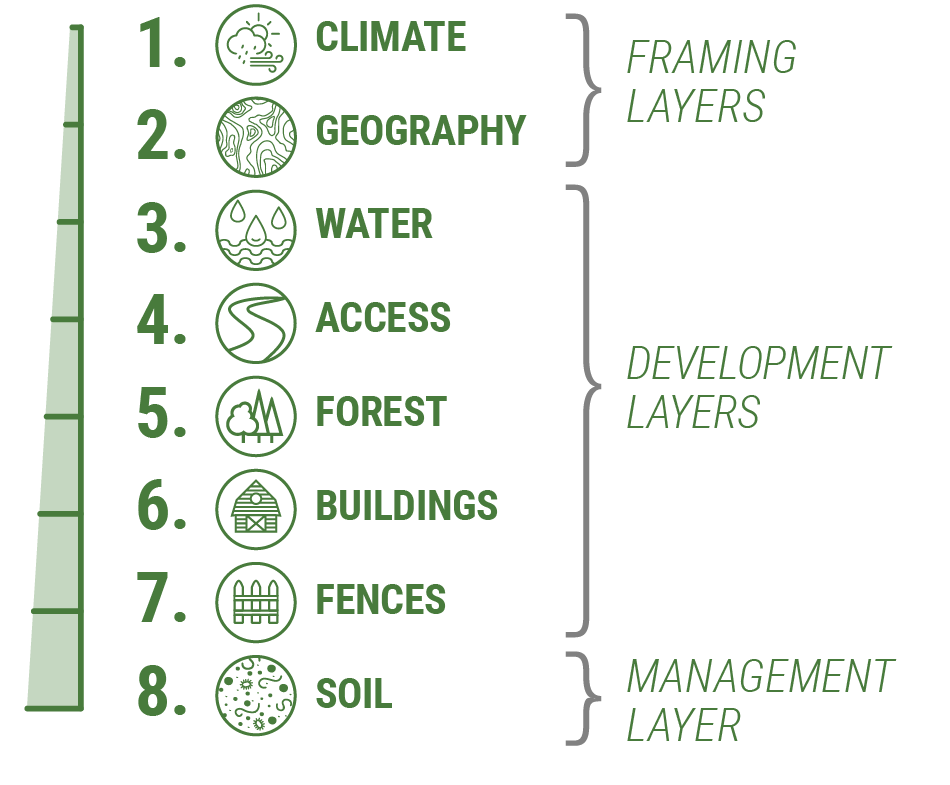Our design approach has been established in relation to P.A. Yeomans ‘Keyline Land Planning System’ and more specifically, the ‘Scale of Permanence’.

Framing Layers
The two framing layers which consist of CLIMATE and GEOGRAPHY are defined as the two factors which are the fixed context within any land-based enterprise.
These are the design parameters within which we have to work and adapt ourselves to. These two layers are the consequence of detailed surveying and analysis. They constrain and exercise some control over the remaining layers and are therefore, fundamental in their conception to assure the greatest outcome.
PREVAILING HUMAN CLIMATE
Understanding and respecting the project context from a human aspect (Holistic Context) concerning all those involved with intent (goal-setting) and have decision-making capabilities.
CLIMATE OF THE BIOSPHERE
The weather conditions which are prevailing in a certain area over time and can be understood specifically regarding its influence on a particular site.
PREVAILING HUMAN CLIMATE
The complete classification and comprehension of the lands shape and its associated features through the analysis of topographical data provided in the form of digital terrain and surface modelling. Utilising this data, we can produce extremely accurate maps and images with high resolution to allow us to understand the landform and bring a physical context to the project.
Development Layers
This layers includes design, planning, evaluations, and implementation.
The five DEVELOPMENT layers are heavily influenced by the FRAMING LAYERS but at the same time, activity from each of the DEVELOPMENT layers feeds back and significantly effects the dynamics of all of the other layers.
Essential for life and one of the most important substances on earth. As a life sustaining force, we must design and manage landscapes to ensure water is effective and availability is understood.
Sources – understanding water flow??? - Storage – Infiltration – Harvesting – Distribution – Diversion
Arteries or networks of movement necessary for the effective management of any system. The correct placement in association with the previous WATER layer is fundamental to create network connectivity and effective movement within a site. Natural land divisions manifest themselves as a consequence providing design opportunities.
Primary Access – Secondary Access – Trails – Nodes – Passing Places – paths -
Vegetation (all plants, trees, and grasses collectively) can play an extremely important role in any landscape whether they are providing important ecological functions, resources, or purely for aesthetical and visual enhancement. Trees and other woody species can form natural or created forms and their placement are defined by the previous four layers.
Shelterbelts – windbreaks – Fodder – Shade – Orchards – Agroforestry – Silvopasture – Riparian Zones - Stand-Alone – Pastures – Grain and Vegetable species
Both permanent and non-permanent buildings are somewhat fixed to the landscape and require strategic placement within the existing planned infrastructure if they are to integrate efficiently and carry-out their intended function.
Homes – Sheds – Storage – Corrals - Livestock infrastructure – Recreational Facilities
Sub-divisions of the land for practical management purposes or protection of certain productive systems and elements. Following topographical patterns, animal behaviours, and perceived management requirements.
Tree lines – Hedgerows – Fixed Fences – Portable Fencing – Hybrid – Zone Protection
Management Layers
Lorem ipsum dolor sit amet, consectetuer adipiscing elit, sed diam nonummy nibh euismod
The five DEVELOPMENT layers are heavily influenced by the FRAMING LAYERS but at the same time, activity from each of the DEVELOPMENT layers feeds back and significantly effects the dynamics of all of the other layers.
The foundation of any healthy land-based project or enterprise because of its influence as part of a thriving and functioning ecosystem. Healthy functioning soil increases productivity as well as social and economic well-being. The focus is on determining the most cost-effective and practical means by which to regenerate and manage healthy soils.